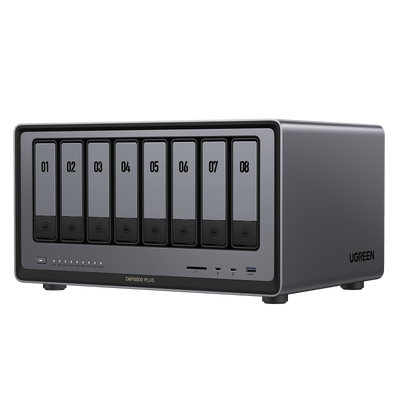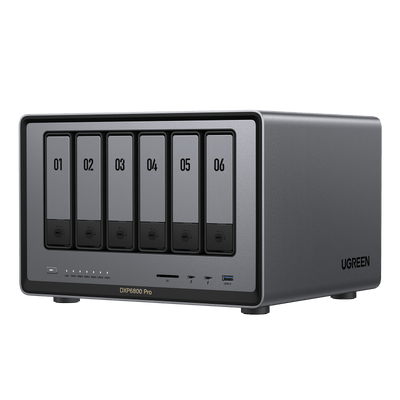Which is Better For Your Data Privacy and Security: NAS or Cloud Storage?
In today’s age, with data breaches becoming more frequent and widespread, choosing the right data storage solution is crucial. Where you keep your data - from personal photos to professional projects - and how you store it can have a significant impact on safety and accessibility.
As cloud storage services proliferate and Network Attached Storage remains popular, many wonder which is better: hosting data at home on a NAS or trusting a cloud provider? Here, we’ll explore the key differences between NAS and cloud storage in terms of privacy, security, cost, and accessibility to help you make an informed decision.
Understanding the Basics NAS storage
Basic Definition
NAS Storage is a dedicated device that provides multiple users with access to data over a network. Unlike conventional hard disk drives, NAS connects to your local network, allowing various devices - computers, smartphones, or smart TVs - to access the stored data simultaneously. Consider it a personal server, sitting in your home or office providing centralized data storage.
NAS systems include their own operating system, which provide functionality from simple file sharing and complex backups to multimedia streaming. For content creators, small businesses, and many more, NAS can be a powerful tool.
Advantages of NAS
Local control is one of the major advantages of NAS storage: the data sits on physical hard drives in your possession, and you have full control over who can access it. That local storage also means that you can be assured of fast access to your files, especially on a high-speed network, without reliance on an internet connection.
Scalability is a major factor. NAS devices, being highly adaptable, have the capacity to accommodate additional hard drives as needs grow. For those who handle large files such as high-resolution videos or extensive photo collections, NAS offers a level of performance and capacity that cloud services can’t readily match without significant costs.
Take the UGREEN NASync DXP8800 Plus as an example. This NAS storage device showcases excellent scalability with its 8-bay design and support for up to 200TB of storage, providing ample room for expansion. Ideal for professionals handling large files, it features dual 10GbE network ports that can be aggregated for 2500MB/s download speeds. Its performance and expandability make it a compelling alternative to cloud services, especially for those working with vast photo collections or ultra-high-resolution videos.

What is Cloud Storage?
A Modern Solution for Data Management
Cloud storage refers to a network of remote servers operated by a third-party, which lets users rent storage space for data. You can think about it like space on a distant NAS device except rather than being in your home, that space is sitting in data centers around the world. Services like pCloud, Google Drive, and Dropbox let you store, manage, and access your files online from any device with an active internet connection.
Cloud storage has grown to be popular because of its ease of use and accessibility, be it in a personal or professional setting. On top of that, most cloud services work on dedicated desktop and mobile applications that work well cross-device.
Advantages of Cloud Storage
One of the biggest advantages of cloud storage is its convenience. One needn’t bother buying hardware or maintaining it, besides the headache of technical setup. Then again, cloud storage provides you with access to your files from anywhere, making it the ideal situation for those who have to collaborate with others or those who are always on the go.
Cloud services also allows for automatic backups and redundancy. Most of them keep your files in triplicate form on different servers so that when one crashes, which is very rare, your data is safe. Modern cloud services also employ client-side encryption, like pCloud, where only you can decrypt your data, hence making it an extra layer of security.
Privacy and Security: NAS vs. Cloud Storage
Cloud Storage: The Privacy Issues
Location of data is one of the major concerns about cloud storage. Because your data will sit on remote servers, often in other countries, it’s subject to a lot of different laws and regulations regarding privacy. This may be problematic if the country where your data sits happens to have weaker privacy protections.
Another issue is third-party access. Under certain conditions, cloud providers may be required to share your data with government agencies or other entities. While encryption can mitigate some of these concerns, the fact remains that you’re entrusting your data to a third party.
Cloud systems are also prime targets for cyber attacks. Although cloud service providers have implemented a variety of security measures, hacking attempts cannot be entirely eliminated and may lead to data leaks and unauthorized access to files. According to Thales’ “2023 Cloud Security Study”, 45% of businesses encountered a cloud-based data breach in the past 12 months. This data underscores the persistent challenges in cloud security.
Advantages in Privacy From NAS
Meanwhile, NAS gives you far more control over your data. Working with NAS, all of your files are stored locally in your home or office and thus are not dependent on some third-party service for transferring access to your data. You are in charge to provide access permission and ensure that only authorized users get the chance to view or make edits to sensitive files.
Many NAS devices also support data encryption and regular backups, giving you the ability to secure your files and restore them in case of hardware failure. However, it should be noted that with NAS, you are responsible for maintaining security protocols and backing up your data yourself, tasks that cloud providers do automatically.
Cost and Maintenance: Which is More Affordable?
Costs of NAS
While NAS has a lot of major positives, there are some negatives in the form of higher upfront costs. You are required to purchase the NAS device, hard drives, and if you want redundancy, you’ll be able to invest in RAID configurations, too.
NAS, though, can actually save you money over time for those with large storage requirements. You only make an initial investment once, and after that, there are no recurring subscription charges. You can continue adding extra drives as required.
Cost of Cloud Storage
Cloud storage generally operates on a subscription model where the user pays monthly or yearly, depending on the amount of storage he or she uses. While it’s more reasonably priced and less expensive up front, it can quickly get very costly over time, especially if you are using a lot or need a lot of space.
Performance and Accessibility
NAS Performance
This is where NAS really shines. For those working with big files and needing access to them quickly, NAS is unparalleled. It also trumps cloud storage on a fast local network in most scenarios, such as video editing or 3D rendering. Setting up NAS for remote access can be a bit more fiddly, as this may require some technical wizardry - say, port forwarding and messing with security settings.
Cloud Storage Performance
Cloud storage has made the handling of files so convenient since you can get access to your files from anywhere, so long as there is an internet connection. In any case, its reliability also rests on your internet speed. It can be slow when you want to download or upload huge files, which is a snag for heavy users of cloud drives. Still, cloud storage is ideal for people working on less intensive files and/or smaller projects.
Use Cases: Which Solution is Right for You?
Photographers and Videographers
NAS is ideal for local storage and fast access to high-resolution photos and videos for professionals who have to deal with big media files. That allows for quick transfers and backups without relying on internet speed. On the other hand, cloud storage can be used to backup important projects or access your files while traveling. Click here to learn about the 6-Bay Dual 10GbE NAS Storage.

Content Creators (YouTubers, Online Influencers)
NAS provides the speed and capacity content creators require to work with large files, while smaller files can easily be accessed and shared on the go with cloud storage. For them, too, a hybrid solution may turn out to be the best - use NAS for local work and cloud backups.
Family Memories
For families that just want to store and share photos and videos, cloud storage will make more sense. It is generally far easier to use, integrated with mobile apps, and you can access the memories from any device remotely. NAS is useful if you have home media servers, but might be a bit more technically oriented in terms of setup and maintenance. Click to learn more about photo storage.
Small Businesses and Enterprise Users
With NAS, businesses that require secure file sharing and collaboration can have a top-notch in-house solution for data control and speedy file access. Conversely, cloud storage provides greater convenience for remote teams with seamless collaboration and built-in security across all projects.
How to Choose the Right Storage Solution
If you’re considering buying either a NAS or cloud storage, here are a few things to consider:
- Storage Requirements: How much data does it require to store? NAS is ideal for large files, while cloud storage is better if the need is smaller and flexible.
- Technological Expertise: When it comes to setting up and maintaining, NAS takes more time than cloud storage, which is fairly effortless to use by non-technical people.
- Privacy Concerns: If data privacy is the bottom line, NAS gives you full control, although modern cloud services offer a good deal of advanced encryption options.
- Budget: While cloud services are somewhat more affordable out of the box and flexible with subscription models, NAS is cheaper for long-term, large-scale storage.
- Mobility: For those who are highly mobile, needing to access their data across several devices when on the go, cloud storage is the more convenient option.
Conclusion
No one-size-fits-all solution exists in the debate between NAS and cloud storage. NAS provides local control and high performance for those with huge data needs, while cloud storage is hands down much easier to use and is accessible in ways NAS isn’t, for users for whom convenience is key. The right choice comes down to specific needs, technical ability, and budget.
The bottom line: A combination of both NAS and cloud storage may give many what they’re after - the perfect balance between security, performance, and convenience.
Whether you are a photographer, a content creator, or simply someone who wants to better protect their data, please feel free to ask questions or share your experiences in the comments section below - we’d love to hear from you!




